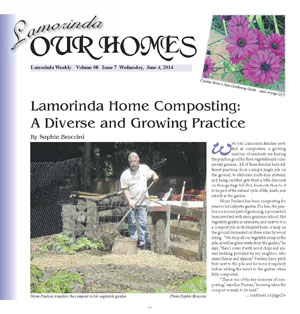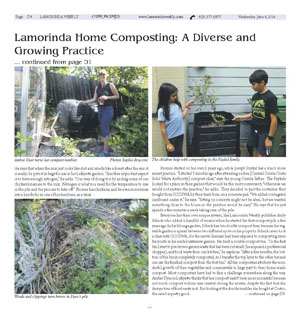|
|
Published June 4th, 2014
|
Lamorinda Home Composting: A Diverse and Growing Practice
|
|
| By Sophie Braccini |
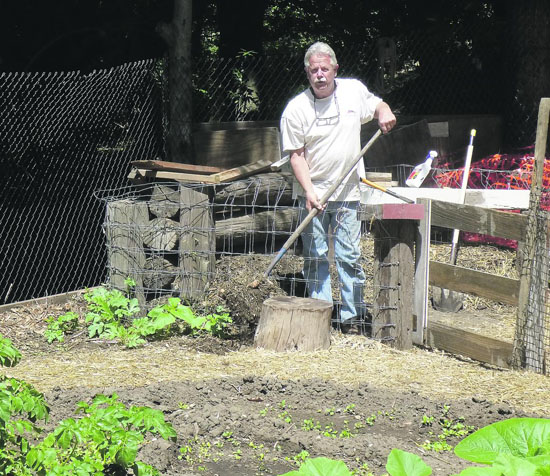 |
| Norm Paulsen transfers the compost in his vegetable garden. Photo Sophie Braccini |
With 545 Lamorinda families certified as composters, a growing number of residents are finding the practice good for their vegetable and ornamental gardens. All of these families have different practices, from a simple single pile on the ground, to elaborate multi-bins systems, and being certified gets them a little discount on their garbage bill. But, foremost, they do it to be part of the natural cycle of life, death, and rebirth in the garden.
 Norm Paulsen has been composting for years in his Lafayette garden. For him, the practice is a normal part of gardening, a process he's been involved with since grammar school. His vegetable garden is extensive, and next to it is a compost pile in its simplest form: a heap on the ground delineated on three sides by wood siding. "We drop all our vegetable scrap in the pile, as well as green waste from the garden," he says, "then I cover it with wood chips and animal bedding provided by my neighbor, who raises llamas and alpacas." Paulsen has a pitch fork next to the pile and he turns it regularly before adding the result to the garden when fully composted.
Norm Paulsen has been composting for years in his Lafayette garden. For him, the practice is a normal part of gardening, a process he's been involved with since grammar school. His vegetable garden is extensive, and next to it is a compost pile in its simplest form: a heap on the ground delineated on three sides by wood siding. "We drop all our vegetable scrap in the pile, as well as green waste from the garden," he says, "then I cover it with wood chips and animal bedding provided by my neighbor, who raises llamas and alpacas." Paulsen has a pitch fork next to the pile and he turns it regularly before adding the result to the garden when fully composted.
 "This is one of the key elements of composting," says Eric Fromer, "knowing when the compost is ready to be used." He says that when the mix just looks like dirt and smells like a forest after the rain it is ready; he puts it in bags for use in his Lafayette garden. "Another important aspect is to have enough nitrogen," he adds. "Our way of doing it is by adding some of our chicken's manure to the mix. Nitrogen is what you need for the temperature to rise in the pile and the process to take off." Fromer has chickens, and he even sometimes lets a hen frolic in one of his tumblers, as a treat.
"This is one of the key elements of composting," says Eric Fromer, "knowing when the compost is ready to be used." He says that when the mix just looks like dirt and smells like a forest after the rain it is ready; he puts it in bags for use in his Lafayette garden. "Another important aspect is to have enough nitrogen," he adds. "Our way of doing it is by adding some of our chicken's manure to the mix. Nitrogen is what you need for the temperature to rise in the pile and the process to take off." Fromer has chickens, and he even sometimes lets a hen frolic in one of his tumblers, as a treat.
 Fromer started on his own 5 years ago, while Joseph Paykel has a much more recent practice. "I started 7 months ago after attending a a free [Central Contra Costa Solid Waste Authority] compost class," says the young Orinda father. The Paykels looked for a place in their garden that would be the most convenient, "otherwise we would not sustain the practice," he adds. They decided to put the container they bought from CCCSWA by their trash bins, on a concrete pad. "We added corrugated cardboard under it," he says. "Sitting on concrete might not be ideal, but we wanted something close to the house so the practice would be easy." He says that he just spends a few minutes a week taking care of the pile.
Fromer started on his own 5 years ago, while Joseph Paykel has a much more recent practice. "I started 7 months ago after attending a a free [Central Contra Costa Solid Waste Authority] compost class," says the young Orinda father. The Paykels looked for a place in their garden that would be the most convenient, "otherwise we would not sustain the practice," he adds. They decided to put the container they bought from CCCSWA by their trash bins, on a concrete pad. "We added corrugated cardboard under it," he says. "Sitting on concrete might not be ideal, but we wanted something close to the house so the practice would be easy." He says that he just spends a few minutes a week taking care of the pile.
 Everyone has their own unique system, like Lamorinda Weekly publisher Andy Scheck who added a handful of worms when he started his first compost pile a few years ago. In his Moraga garden, Scheck has two double compost bins, because his vegetable garden is spread between two different spots on his property. Scheck never took a class with CCCSWA, for the native German had been exposed to composting since his youth in his uncle's extensive garden. He built a double compost bin. "In the first bin I start to pile brown garden waste that has been cut small (he acquired a professional chopper), and food waste from our kitchen," he explains. "After a few months, the bottom of the bin is completely composted, so I transfer the top layer to the other bin and can use the finished compost from the first bin." All the composters attribute the wonderful growth of their vegetables and ornamentals in large part to their home-made compost. Most composters have had to face a challenge somewhere along the way. Amber Dyer in Lafayette thinks that her compost hasn't been more successful because not much compost volume was created during the winter, despite the fact that she dumps tons of food waste in it. But looking at the double tumbler she bought at Costco, the result is pretty good.
Everyone has their own unique system, like Lamorinda Weekly publisher Andy Scheck who added a handful of worms when he started his first compost pile a few years ago. In his Moraga garden, Scheck has two double compost bins, because his vegetable garden is spread between two different spots on his property. Scheck never took a class with CCCSWA, for the native German had been exposed to composting since his youth in his uncle's extensive garden. He built a double compost bin. "In the first bin I start to pile brown garden waste that has been cut small (he acquired a professional chopper), and food waste from our kitchen," he explains. "After a few months, the bottom of the bin is completely composted, so I transfer the top layer to the other bin and can use the finished compost from the first bin." All the composters attribute the wonderful growth of their vegetables and ornamentals in large part to their home-made compost. Most composters have had to face a challenge somewhere along the way. Amber Dyer in Lafayette thinks that her compost hasn't been more successful because not much compost volume was created during the winter, despite the fact that she dumps tons of food waste in it. But looking at the double tumbler she bought at Costco, the result is pretty good.
 "For the compost process to happen, you need heat and you need moisture," says Paykel, adding that the CCCSWA workshop he attended last year taught him all he needed to know. For him the challenge was ants, and what he found was that the little critters were taking over the pile when it was too dry. Scheck had a problem that no one would want: rats. "Since I put wooden compost boxes on concrete pavers, I have had no more problems," he says. None of the people reported any unpleasant smell coming out of the pile.
"For the compost process to happen, you need heat and you need moisture," says Paykel, adding that the CCCSWA workshop he attended last year taught him all he needed to know. For him the challenge was ants, and what he found was that the little critters were taking over the pile when it was too dry. Scheck had a problem that no one would want: rats. "Since I put wooden compost boxes on concrete pavers, I have had no more problems," he says. None of the people reported any unpleasant smell coming out of the pile.
 "Yard and food waste represent 30 percent of the waste stream; we encourage people to compost to reduce the volume of what has to be hauled away," says CCCSWA Ashley Louisiana. On the authority's website residents can purchase bins at a reduced price and check out the dates of free upcoming workshops. In order to get certified, residents need to either have purchased a bin from CCCSWA or send pictures of their practice.
"Yard and food waste represent 30 percent of the waste stream; we encourage people to compost to reduce the volume of what has to be hauled away," says CCCSWA Ashley Louisiana. On the authority's website residents can purchase bins at a reduced price and check out the dates of free upcoming workshops. In order to get certified, residents need to either have purchased a bin from CCCSWA or send pictures of their practice.
 "This is an Honor system," adds Louisiana.
"This is an Honor system," adds Louisiana.
 The Skinny About Composting
The Skinny About Composting

 A balance of browns (fallen leaves, straw, wood chips) and greens (grass clippings and food scraps) is all you need to make compost. Compost needs heat and moisture. Composting containers vary from a simple pile on the ground, to a series of bins that can be made of different wood or plastic. The next compost workshop in Lamorinda is scheduled for Saturday, June 7 in the Lafayette Community Garden. For more information, go to wastediversion.org.
A balance of browns (fallen leaves, straw, wood chips) and greens (grass clippings and food scraps) is all you need to make compost. Compost needs heat and moisture. Composting containers vary from a simple pile on the ground, to a series of bins that can be made of different wood or plastic. The next compost workshop in Lamorinda is scheduled for Saturday, June 7 in the Lafayette Community Garden. For more information, go to wastediversion.org.

|
 |
| Amber Dyer turns her compost tumbler. Photos Sophie Braccini |
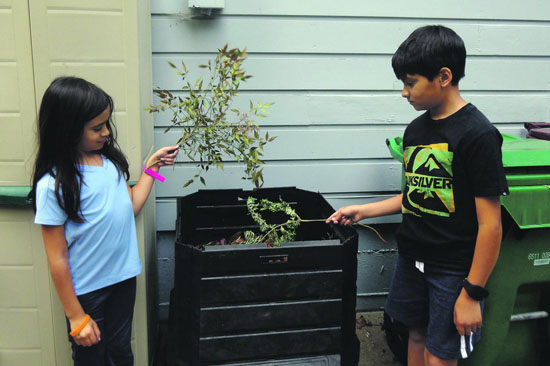 |
| The children help with composting in the Paykel family. |
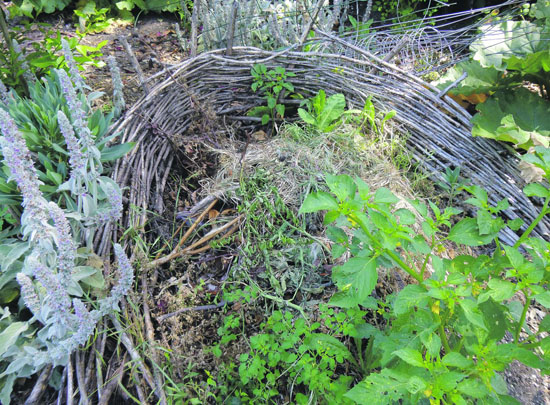 |
| Weeds and clippings turn brown in Dyer's pile. |
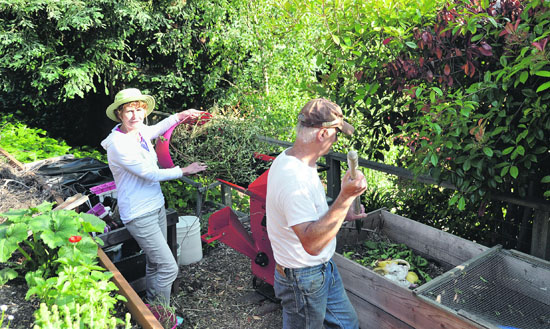 |
| Wendy Scheck chips yard clippings while her husband, Andy, turns the compost.
Photo Jaya Griggs |
| |
|
|
|
|







